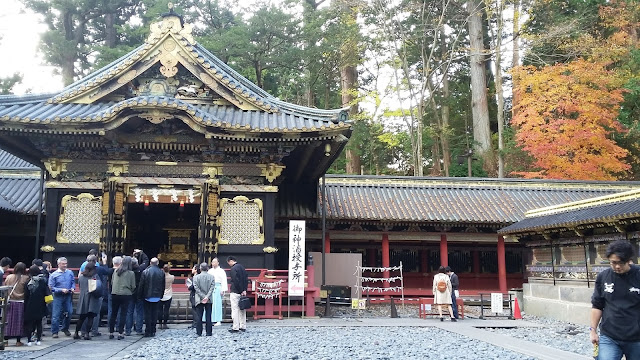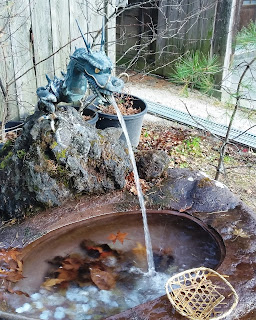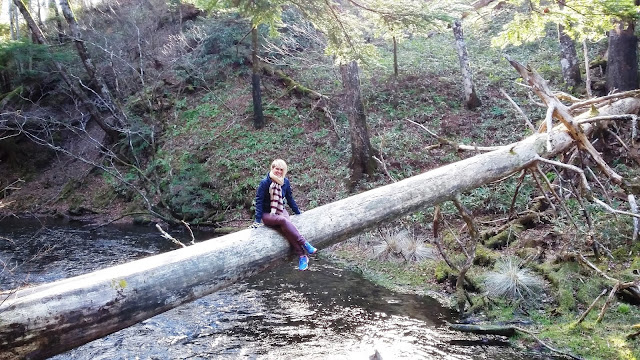Dear friends,
It's almost been three months since I came to Japan, and already has the country been shaken by a major earthquake and even tsunami warning. No one has been hurt, thankfully - but I received a few concerned messages last Tuesday after the Fukushima earthquake could also be felt in Tokyo. Everything is alright and I am already getting used to be woken up by an earthquake early in the morning ;)
But let's talk about something more cheerful: It's almost Christmas! And Japan is already busy preparing. This is the reason for this post's title - the most prevalent thing in this time of the year. Because, for example, this is what Ginza, Tokyo's high-end shopping area, looks like now:
In fact, it has also been snowing here a few days ago. I heard this is the first time in 50 years that Tokyo got snow in November! However, there was little time to appreciate this wonder it all melted away...
 |
| Snowy view from my balcony |
Celebrating like anime characters
The reason why we recently had one week off from class was a big campus festival called Mitasai - Mita Festival. All Japanese students had been preparing all week to finally be able to start on Thursday. The Keio University's Mita campus had been decorated, food booths stocked up and performances rehearsed. We visited the festival on Sunday and I must say: It was worth the effort! We felt like in one of the high school festivals you can so often see in manga and anime. And we had a lot of delicious things to eat - Takoyaki, noodles, french fries, crêpes, Korean pancakes, ice cream,...
 |
| A small stage - see the following video for proof that Japanese can get very enthusiastic about their favourite music ;) |
The main reason why we had to go there was to see our Bojutsu club performing. Although we ourselves were not yet skilled enough to participate, we could watch all members demonstrating various techniques of this martial art. We were impressed and are even more motivated to learn all these amazing moves now. But see for yourself!
When it was time for the obligatory group picture, the members saw us watching and called for us to come to pose for the photo as well. It was so touching - we felt welcome and like real members of the club!
 |
| It won't be hard to find us in the photo |
 |
| A big stage with continuous performances - like those in the videos below |
 |
| They were apparently actually fighting - I heard that "Trump" was seen on this ring as well. Even here, you are not safe from talks about the US election... |
In one of the school buildings, all musical clubs of Keio gathered and gave performances in each of the rooms. A diversity from classical music over folk and jazz to metal. And some of them were really good!
 |
| Rock/metal stage |
 |
| Our favourites: A jazzy style music with rock elements |
 |
| A capella performance on the small stage |
 |
| Dancing performance at the end of the day |
Disneyland for drunkards
Last week, the Keio WelcomeNet organised a tour to a sake brewery - Ishikawa in the Fussa area of Tokyo. This brewery is quite old, founded in 1863 and also incorporates a museum and a couple of restaurants. A friendly guide showed us around the premises and explained about the process of brewing sake.
Sake is not quite wine and not quite beer - but something inbetween. While yeast and fermentation of a starchy grain are involved in the process, the variety of flavours more likely resembles wine. However, it contains more alcohol than both of them - 14 to 16%.
To make sake, rice is steamed in mineral water (tap water is not used, but water from natural sources only), then made into a mold called koji. This mold serves to turn the starch in the rice into glucose. The koji is then mixed with yeast and lactic acid and left to ferment. This mixture is called shubo and is cultivated in a smaller tank first to maintain a necessary temperature, then, after 14 days, it is put into a large fermentation tank.
 |
| The sake mixture is fermenting in these tanks - up to one year |
The sake here is only produced in winter, which is due to the rigid rice economy policy by the government on the one hand, but on the other hand, the necessary low temperature with fewer germs also plays a role.
 |
| A giant kettle - I forgot what it is for :( |
The brewery itself is considered a holy place, this is why you can find Shinto paper charms and tiny shrines all over the place.
Ishikawa does not only produce sake, but also beer. Since you can learn so much about the things brewed here and try them in the local restaurants, this place is called the Disneyland for sake and beer lovers. They make all kinds of beer with German names - so funny when our guide told us of Helles, Pilsner, Dunkles, Weizen...
 |
| Of course, you could buy all this in a shop on the site |
The highlight was, of course, the sake tasting. We got three different flavours: One was very dry, the second a lot more sweet fruity (the best sake I ever had!) and the third one was, in fact, plum wine. They even have sake flavoured cake and sweets... indeed a Disneyland if you are into the Japanese rice drink.
The world of Noh
In our Arts Workshop, we had another special guest lask week. It was the Noh player Kohei Kawaguchi, who taught us about this traditional Japanese type of drama, and even performed an excerpt of a play he recently participated in. As it seems to be the custom in this class, we were also invited to sing with him - not exactly easy with a complex Japanese text and a very unusual tune! Unfortunately, I even forgot to take photos or videos - but in January, we will be attend his performance in the Umekawa Theatre. Hopefully, I will be give a small insight into this art form then.
Noh had recently been proclaimed UNESCO Cultural Heritage, and have been around for over 700 years now. The unique thing about Noh is... well, there are quite a few things. A Noh drama is mostly based on mythology and religion, which is why we can often see a pine tree in the background: Pine trees are considered to be inhabited by gods, and so the play is performed for the particular god in the tree. Since there are hundreds of plays, a Noh actor only has the chance to play in each of them once. He also trains alone, without stage rehearsals. Kawaguchi-san said that the particular song we learned took him one year to learn. One year!
Another remarkable feature of a Noh drama are the masks. They stand for different characters as well as states of mind. The latter can often be changed using only one mask, which is achieved by slightly changing the position of the head. The different angle creates a new expression - for example, sadness with a head tilted downwards. Other ways to express moods and feelings are gestures and fan movements.
 |
| This mask is supposed to show a sad young woman. Could you have guessed? |
 |
| These fans, as well as the masks, are hundreds of years old |
Thank you for reading! Enjoy this pre-Christmas season and come back to visit here in the next few days, when I will tell - and show - you about the beautiful city of Kamakura and one of the biggest Japanese cultural festivals. :)



























































































